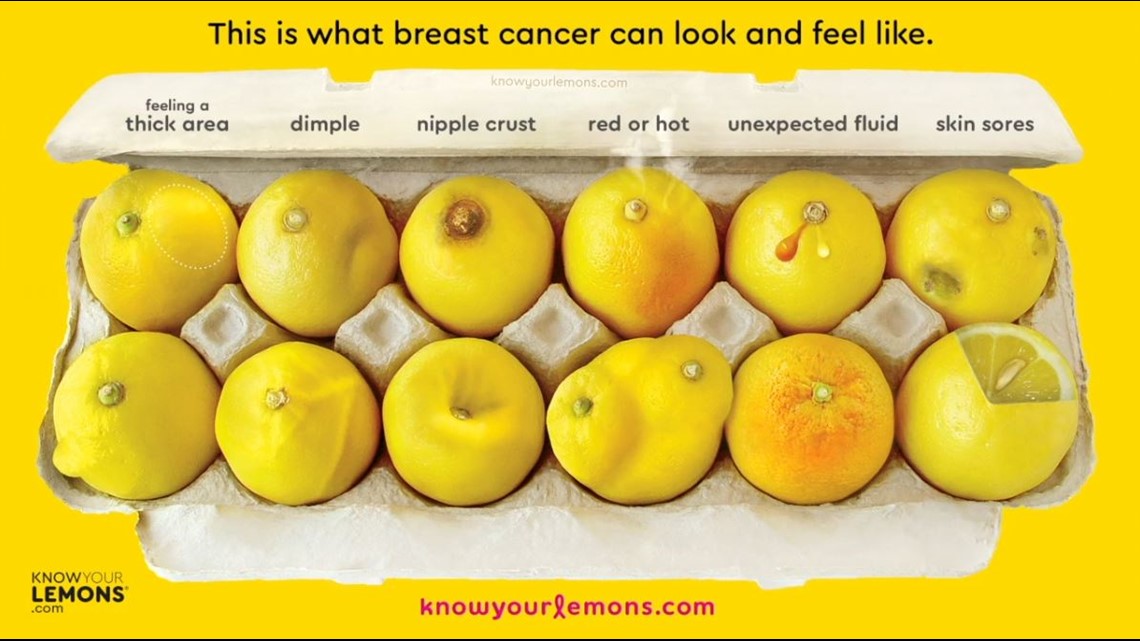GREENSBORO, N.C. (WFMY) -- Whether you call it your mangos, watermelons, or peaches bottom line you should be touching and feeling your LEMONS!
Yes, LEMONS! Whatever you call it, you should be touching your breasts, and this is a message for both women and men.
TOUCH YOUR LEMONS
FACT: 1 in 8 Women Will Be Diagnosed With Breast Cancer In Her Lifetime
Breast cancer is the most commonly diagnosed cancer in women and 2,470 men will be diagnosed with it each year.
Speaking of lemons, the “Know Your Lemons” campaign helps to simplify breast cancer education using an image of 12 lemons in an egg carton to represent the signs of breast cancer.
In fact there’s an app for just that and it’s even more simple to use.
The “Know Your Lemons” app allows you how to do self-exam, book a mammogram, provide resources, and help you prepare for a breast test and more.
HOW OFTEN DO I NEED TO TOUCH MY LEMONS?
Women should perform breast self-exams at least once a month.
FACT: 40-percent of diagnosed breast cancers are detected by women who feel a lump
Breast self-exams help you to become more familiar with how your breasts look and feel so you can alert your doctor to any changes.
HOW TO DO A BREAST SELF-EXAM
A good resource to walk you through how to do a breast self-exam is by downloading and using the “Know Your Lemons” App.
You can perform a breast self-exam in the shower, in front of a mirror or lying down.
The National Breast Cancer Foundation reveals doing the following for an exam:
1) IN THE SHOWER
Using the pads of your fingers, move around your entire breast in a circular pattern moving from the outside to the center, checking the entire breast and armpit area.
- Check both breasts each month feeling for any lump, thickening, or hardened knot. Notice any changes and get lumps evaluated by your healthcare provider.
2) IN FRONT OF A MIRROR
Visually inspect your breasts with your arms at your sides. Next, raise your arms high overhead.
Look for any changes in the contour, any swelling, or dimpling of the skin, or changes in the nipples. Next, rest your palms on your hips and press firmly to flex your chest muscles. Left and right breasts will not exactly match—few women's breasts do, so look for any dimpling, puckering, or changes, particularly on one side.
3) LYING DOWN
When lying down, the breast tissue spreads out evenly along the chest wall. Place a pillow under your right shoulder and your right arm behind your head. Using your left hand, move the pads of your fingers around your right breast gently in small circular motions covering the entire breast area and armpit.
Use light, medium, and firm pressure. Squeeze the nipple; check for discharge and lumps. Repeat these steps for your left breast.
BREAST CANCER SIGNS AND SYMPTOMS
The National Breast Cancer Foundation reveals looking for the following breast or nipple changes:
A CHANGE IN HOW THE BREAST OR NIPPLE FEELS
- Nipple tenderness or a lump or thickening in or near the breast or underarm area
- A change in the skin texture or an enlargement of pores in the skin of the breast (some describe this as similar to an orange peel’s texture)
- A lump in the breast (It’s important to remember that all lumps should be looked at by your doctor, but not all lumps are cancerous.)


A CHANGE IN THE BREAST OF NIPPLE APPEARANCE
- Any unexplained change in the size or shape of the breast
- Dimpling anywhere on the breast
- Unexplained swelling of the breast (especially if on one side only)
- Unexplained shrinkage of the breast (especially if on one side only)
- Recent asymmetry of the breasts (Although it is common for women to have one breast that is slightly larger than the other, if the onset of asymmetry is recent, it should be checked.)
- Nipple that is turned slightly inward or inverted
- Skin of the breast, areola, or nipple that becomes scaly, red, or swollen or may have ridges or pitting resembling the skin of an orange
ANY NIPPLE DISCHARGE
- It is also important to note that a milky discharge that is present when a woman is not breastfeeding should be checked by her doctor, although it is not linked with breast cancer.
BREAST CANCER IN MEN
Men should also be concerned with breast cancer. It’s usually detected as a hard lump underneath the nipple and areola for men according to the National Breast Cancer Foundation.
FACT: Male breast cancer can exhibit the same symptoms as breast cancer in women
Men carry a higher mortality than women do, primarily because awareness among men is less and they are less likely to assume a lump is breast cancer.
Of the men who develop breast cancer, the vast majority of those cases are Infiltrating Ductal Carcinoma (IDC), which means cells in or around the ducts begin to invade the surrounding tissue.
RESOURCES
Find a Breast Cancer Support Group Near You
Alight Foundation In Greensboro
Cone Health Breast Cancer Support Groups/Classes
Wake Forest Baptist Health
► Make it easy to keep up to date with more stories like this. Download the WFMY News 2 App: Apple Users, Android Users

